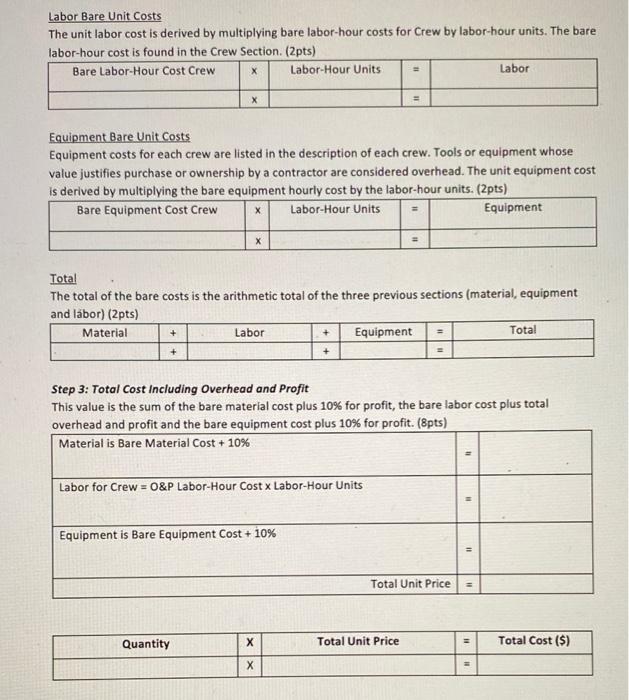A large construction company is removing 200,000 B.C.Y. of earthwork. Complete the unit cost steps using the following information: . . . Daily Crew Output: 440 CY/day Labor Hours: 0.032 hour/C.Y. Material Cost: $0/C.Y. Bare Labor-Hour Cost Crew: $40.14/hour Bare Equipment Cost Crew: $113.07/hour O&P Labor-Hour Cost: $60.51/hour . . According to the calculation steps, record your answers in the table below.
Step 1: Productivity: Daily Output / Labor Hours The "Daily Output" represents the typical number of units the designated crew will install in a normal 8- hour day. To find the number of days the given crew would require to complete the installation, divide your quantity by the daily crew output. (2 pts) Quantity 1 Daily Output Duration / The "Labor-Hours" figure represents the number of labor-hours required to install one unit of work. To find out the number of labor-hours required for your particular task, multiple the quantity of the item times the number of labor-hours shown. (2pts) Quantity Productivity Rate Duration Step 2: Bare Unit Costs Material Bare Unit Costs The unit material cost is the "bare" material cost with no overhead or profit included. Cost shown reflect the national average material prices for January of the current year and include delivery to the job site. No sales taxes are included. (2pts) Labor Bare Unit Costs The unit labor cost is derived by multiplying bare labor-hour costs for Crew by labor-hour units. The bare labor-hour cost is found in the Crew Section. (2pts) Bare Labor-Hour Cost Crew Labor-Hour Units Labor X Equipment Bare Unit Costs Equipment costs for each crew are listed in the description of each crew. Tools or equipment whose value justifies purchase or ownership by a contractor are considered overhead. The unit equipment cost is derived by multiplying the bare equipment hourly cost by the labor-hour units. (2pts) Bare Equipment Cost Crew Labor-Hour Units Equipment X X Total The total of the bare costs is the arithmetic total of the three previous sections (material, equipment and labor) (2pts) Material Labor Equipment Total + + Step 3: Total Cost Including Overhead and Profit This value is the sum of the bare material cost plus 10% for profit, the bare labor cost plus total overhead and profit and the bare equipment cost plus 10% for profit. (8pts) Material is Bare Material Cost + 10% Labor for Crew =0&P Labor-Hour Cost X Labor-Hour Units E Equipment is Bare Equipment Cost + 10% Total Unit Price Quantity Total Unit Price Total Cost ($)








